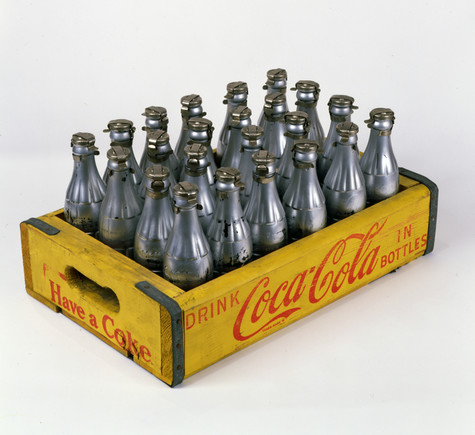The following assessments can be used for this lesson using the downloadable assessment rubric.
- Aesthetics 3
- Communication 4
- Creative process 4
- Creative process 5
- Critical thinking 2
- Historical context 1

Andy Warhol, You're In, 1967
The Andy Warhol Museum, Pittsburgh; Founding Collection, Contribution The Andy Warhol Foundation for the Visual Arts, Inc.
© The Andy Warhol Foundation for the Visual Arts, Inc.
1998.1.789a-x
For Warhol, popular mass-produced food items represented the best of American consumerist society. What could be better than a product, such as Campbell’s Soup or Coca-Cola, which was distributed in vast quantities worldwide and the quality consistent and the price affordable? Although he had made paintings of Coke bottles in the early 1960s, in 1967 the artist turned to a sculptural intervention using actual soda pop bottles (originally conceived by the renowned designer Raymond Loewy), which he coated with silver paint. Three years later, Warhol went a step further by capping 100 silver bottles and filling them with perfume, which he rakishly labeled “You’re In”/“Eau d’Andy.” Unsurprisingly, the Coca-Cola Company responded with a cease and desist letter.
What’s great about this country is that America started the tradition where the richest consumers buy essentially the same things as the poorest. You can be watching TV and see Coca-Cola, and you can know that the President drinks Coke, Liz Taylor drinks Coke, and just think, you can drink Coke, too. A Coke is a Coke and no amount of money can get you a better Coke than the one the bum on the corner is drinking. All the Cokes are the same and all the Cokes are good. Liz Taylor knows it, the President knows it, the bum knows it, and you know it.
Andy Warhol, The Philosophy of Andy Warhol (From A to B and Back Again), 1975
This project works best as an overnight assignment so that students can be responsible for finding materials to match their ideas.
Aesthetics questions for discussion:
Critically respond to Warhol’s You’re In and Kaino’s Graft (Ostrich) using the 4Cs evaluation system.
The following assessments can be used for this lesson using the downloadable assessment rubric.